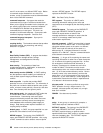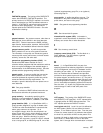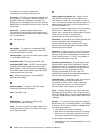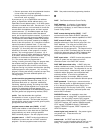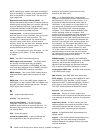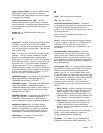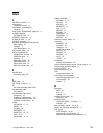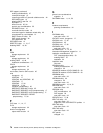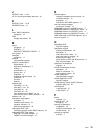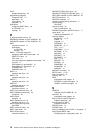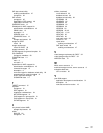sysplex communication. An optional RACF function
that allows the system to use XCF services and
communicate with other systems that are also enabled
for sysplex communication.
system authorization facility (SAF). An MVS
component that provides a central point of control for
security decisions. It either processes requests directly
or works with RACF or another security product to
process them.
system call. In OpenEdition MVS, synonym for
callable service
.
T
target node. An RRSF node that a given RRSF node
is logically connected to, as a result of a TARGET
command. The local node is a target node of itself, and
all of its remote nodes are target nodes. See also
local
node
,
remote node
.
task. (1) A basic unit of work to be accomplished by a
computer. The task is usually specified to a control
program in a multiprogramming or multiprocessing
environment. (2) A basic unit of work to be performed.
Some examples include a user task, a server task, and
a processor task. (3) A process and the procedures
that run the process. (4) In a multiprogramming or
multiprocessing environment, one or more sequences of
instructions treated by a control program as an element
of work to be accomplished by a computer. (5) The
basic unit of work for the MVS system.
TOKENBLD request. The issuing of the RACROUTE
macro with REQUEST=TOKENBLD specified. A
TOKENBLD request builds a UTOKEN.
TOKENMAP request. The issuing of the RACROUTE
macro with REQUEST=TOKENMAP specified. A
TOKENMAP request maps a token in either internal or
external format, allowing a caller to access individual
fields within the UTOKEN.
TOKENXTR request. The issuing of the RACROUTE
macro with REQUEST=TOKENXTR specified. A
TOKENXTR request extracts a UTOKEN from the
current address space, task or a caller-specified ACEE.
transaction program (TP). A program used for
cooperative transaction processing within an SNA
network. For APPC/MVS, any program on MVS that
issues APPC/MVS or CPI Communication calls, or is
scheduled by the APPC/MVS transaction scheduler.
TSO segment. The portion of a RACF profile
containing TSO logon information.
U
UACC. See
universal access authority
.
UID. See
user identifier
.
universal access authority (UACC). The default
access authority that applies to a resource if the user or
group is not specifically permitted access to the
resource. The universal access authority can be any of
the access authorities.
user. A person who requires the services of a
computing system.
user ID. A string of characters that uniquely identifies
a user to a system. A user ID is 1 to 8 alphanumeric
characters. On TSO, user IDs cannot exceed 7
characters and must begin with an alphabetic, #, $, or
@ character.
user identification and verification. The acts of
identifying and verifying a RACF-defined user to the
system during logon or batch job processing. RACF
identifies the user by the user ID and verifies the user
by the password or operator identification card supplied
during logon processing or the password supplied on a
batch JOB statement.
user identifier (UID). (1) A unique string of characters
that identifies an operator to the system. This string of
characters limits the functions and information the
operator can use. (2) A non-negative integer, which
can be contained in an object of type
uid_t,
that is used
to identify a system user. When the identity of the user
is associated with a process, a user ID value is referred
to as a real user ID, an effective user ID, or an
(optional) saved set-user-ID. (3) The identification
associated with a user or job. The two types of user
IDs are:
RACF user ID: A string of characters that uniquely
identifies a RACF user or a batch job owner to the
security program for the system. The batch job
owner is specified on the USER parameter on the
JOB statement or inherited from the submitter of the
job. This user ID identifies a RACF user profile.
OMVS user ID: A numeric value between 0 and
2147483647, called a UID (or sometimes a user
number), that identifies a user to OpenEdition
services. These numbers appear in the RACF user
profile for the user.
A user ID is equivalent to an account on a UNIX-type
system. (4) A symbol identifying a system user.
(5) Synonymous with user identification.
user name. (1) In RACF, one to 20 alphanumeric
characters that represent a RACF-defined user. (2) In
Glossary 71






